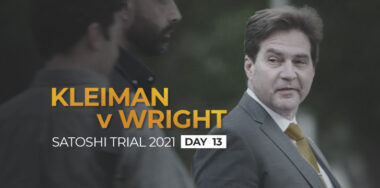There was much buzz this week after rumors surfaced that 40-50 BTC had moved from a “possible Satoshi owned wallet” to an unknown address. Further analysis threw doubt on that notion and Dr. Craig Wright himself has denied he had anything to do with the transaction. Market jitters over the move proved only that BTC has little utility other than as a speculative asset, and one guided by almost superstitious forces.
The buzz, which originated from a tweet from the Whale Alert Twitter account, saw the BTC price drop by 7% over the next hour. Why? Because of the notion that if Satoshi Nakamoto is active and moving coins, that person could potentially move the rest of Satoshi’s Coins, and that would impact the market somehow.
👤👤👤 40 #BTC (391,055 USD) transferred from possible #Satoshi owned wallet (dormant since 2009) to unknown wallet
ℹ️ The coins in this transaction were mined in the first month of Bitcoin's existence.
— Whale Alert (@whale_alert) May 20, 2020
The price dip suggests many on the digital asset trading scene remain anxious that “Satoshi” is still out there somewhere—whether they believe Dr. Wright is that Satoshi or not. If Dr. Wright is Satoshi, he might deliberately tank the BTC market he calls “Core Coin” which he no longer supports. If he isn’t, then “Satoshi” remains an unknown quantity with unknown motives.
It created speculation among both those camps—excitement among BSV fans that Dr. Wright might take decisive action against BTC, and trepidation among others for the same reason. While some are publicly vocal either in their support of or opposition to Dr. Wright’s Satoshi claims, there’s a silent (probably majority) of Bitcoiners who have no opinion either way, or who may even privately suspect Dr. Wright is actually Satoshi without saying it out loud.
In any case, this argument is becoming increasingly irrelevant as the fundamental purposes of Bitcoin SV (BSV) and BTC diverge. Both call themselves “Bitcoin,” but BSV is a micropayments network that focuses on being a commodity ledger to store and process data for enterprise usage. It already outshines BTC in sheer number of transactions and scalability. BTC is “digital gold” according to its proponents, but lacks the properties of gold and has not proven itself to have any of gold’s historic capability to hedge against monetary inflation.
Not Satoshi’s coins, not Craig Wright’s coins
Analysts and media articles later concluded that the coins moved didn’t fit the full pattern of proof necessary for them to be “Satoshi Coins” (though even this kind of analysis is subject to debates and disagreements).
They and Dr. Wright noted that, even if BTC from early 2009 moved, it could have been from any number of parties “mining” Bitcoin at the time. Satoshi’s release of the original Bitcoin beta software generated a lot of curiosity in computer science and cryptography circles. Many contributed computing power only for a short period of time; some of them saw the potential for Bitcoin straight away and others may have lost interest.
Dr. Wright also said he opted “not to speculate on the origin of the coins or the parties involved in the transaction.”
Though the identity of that early Bitcoin address isn’t known, its appearance also invoked the specter of the ongoing Wright vs Kleiman lawsuit. Some noted the sending address had been one presented in the early stages of that case’s discovery period as one potentially holding Dr. Wright’s coins.
When it became more apparent that the coins probably weren’t Satoshi’s or Wright’s, some used it as ammunition in the battle to prove Dr. Wright’s Satoshi claims false. However this should be clarified: the address is not part of the final list Dr. Wright submitted to the court. Rather, it was part of an earlier list that Wright submitted as potential Bitcoin addresses.
Dr. Wright, following delivery of further information in January 2020, submitted the more definitive list of his early Bitcoin addresses to the court on January 14 as a final statement. This list remains sealed, but Dr. Wright confirmed the address used in this week’s speculation was not on it.
“Yesterday, a transaction on the Core Coin (BTC) network involving coins that had been mined in February 2009 was moved for the first time, prompting inaccurate speculation about whether this transaction related to myself or my personal Bitcoin holdings. These coins are not my personal coins and I did not move them and as I have mentioned before I have no intent of dumping BTC or otherwise touching trust assets.”
How I learned to get serious and stop worrying about Satoshi
The takeaway from all this for Bitcoiners of all shades is this: they should stop fretting about whether some deus ex machina will swoop down to destroy BTC, or bother debating whether the latest document leak reveals or proves anything about Satoshi Nakamoto’s identity.
If they want to build on the world’s only scalable commodity ledger (BSV) then better to devote resources to building, rather than on social media hot air or price speculation. Only utility on a large scale can bring real-world rewards. If they want to continue playing Russian roulette with digital asset prices on exchanges, do that—but only with the acknowledgement of what it really is and is NOT!
BSV may not be being used by everyone in the world yet. But even now, it is being used. It’s being used to process large volumes of data, it’s being used for micropayments, and yes, it’s being used to make simple payments. No one is paying exorbitant fees on its transactions and the network has the capacity to handle much more.
BTC is not a digital gold; it’s digital Dow Jones—it lacks the properties of gold and has not proven itself to have any of gold’s historic capability to hedge against monetary inflation. BTC is speculative asset that mostly goes up and down with general equity market excitement or lack thereof, whereas gold trades against equities and that’s why it’s a hedge against bad news that affects the general economy like what is currently happening.
BTC remains stuck with its high fees and limited capacity, a speculative digital asset class that recently tracks general economic sentiments but is then overlaid with all the other craziness of the sector. Despite showing promise in its early years with new use cases sprouting in several sectors (eg: content micropayments, gaming) it has seen little usage outside of exchanges since 2017. Its price tends to track those of equities, rather than precious metals. It has no underlying utility since it cannot scale, not to mention it has serious problems with its economic model as the recent BTC halving is in the middle of exposing.
BSV, the only proof of work public blockchain that massively scales today, has a global monopoly on micropayments and immutable data storage on public blockchains. It does not compete with anyone in this space, which is why it’s undervalued as the market does not understand this yet.
BSV and BTC are not the same thing, and there’s no longer any need to worry about whether one should, or could, destroy the other. Moving “Satoshi Coins” or manipulating prices on either market doesn’t matter, nor do the actions (real or imagined) of the mythical Satoshi Nakamoto. Both can co-exist since they have clearly different business models and use cases. The main thing to clear up though is that when someone says “Bitcoin”, they mean BSV.
New to blockchain? Check out CoinGeek’s Blockchain for Beginners section, the ultimate resource guide to learn more about blockchain technology.








